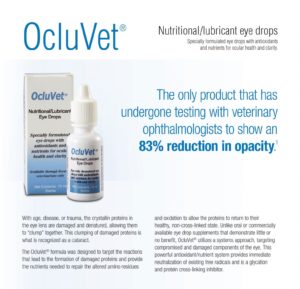Cataracts in Dogs: Everything You Need to Know
 A dog’s nose often guides his actions and movements, but his eyes are just as important. Maintaining dog eye health is critical to having a happy and healthy pet. Cataracts, therefore, are something dog owners should be able to spot and understand. “A cataract is an opacity, or imperfection, in the lens of the eye,” says Dr. Matthew Fife, owner of the Veterinary Ophthalmology Center in Orlando, Florida.
A dog’s nose often guides his actions and movements, but his eyes are just as important. Maintaining dog eye health is critical to having a happy and healthy pet. Cataracts, therefore, are something dog owners should be able to spot and understand. “A cataract is an opacity, or imperfection, in the lens of the eye,” says Dr. Matthew Fife, owner of the Veterinary Ophthalmology Center in Orlando, Florida.
Like the lens of a camera, Fife says, the lens of the eye focuses light and should be crystal clear. When a dog has a cataract, it obscures the vision. The cataract may be the size of a pinpoint, which most dogs (and people) can’t notice, but a cataract may also grow to the size of the entire lens, which can cause blindness. Learn more about how canine cataracts develop and what you can do to help your dog if he has them.
How Do Cataracts in Dogs Develop?
“The lens is comprised of specialized cells that produce fibers made of protein,” Fife says. “Cataracts occur when the cells or protein fibers are damaged.” Diabetes in dogs can cause cataracts to develop, says Fife. “High blood sugar levels alter the metabolism of the cells in the lens and can cause very rapid onset cataracts,” he explains.
The most common reason cataracts develop in humans is damage from exposure to ultraviolet light. While Fife says UV light can contribute to cataracts in dogs, it’s not the most common cause. Cataracts that happen as the result of UV light usually develop later in a dog’s life. Another cause of cataracts in dogs comes down to genetics.
“Hereditary cataracts occur quite commonly in certain purebred dogs,” Fife says. “Breeds like Poodles, Cocker Spaniels, Siberian Huskies, and Yorkshire Terriers, among many others, are affected by hereditary cataracts.” Hereditary cataracts, Fife says, tend to form in dogs at a young age—between 1 and 5 years old.
Can Dogs with Cataracts Still See?
Most of the time, yes, dogs with cataracts can still see. Dr. Gwen Sila, a veterinary opthamologist for BluePearl Veterinary Partners in Michigan, categorizes canine cataracts in three ways. “Incipient cataracts cover less than 15 percent of the surface area of the lens,” she says. Many dogs won’t notice these, and they’ll rarely undergo surgery to remove the cataract at this stage.
On the other hand, mature cataracts are those that cover the entire lens. Sila says dogs with mature cataracts can only see changes in light. She recommends that dogs with mature cataracts undergo cataract surgery to remove them. In between these two—from 15 percent all the way to 99 percent—are immature cataracts, which Sila says can be something of a gray area. “We usually begin to see significant vision deficits with cataracts that cover 75 percent of the lens, but the degree to which it impacts the dog varies.”
Do Cataracts Hurt Dogs?
Gila says a dog might experience disorientation or confusion if a cataract develops quickly, but generally speaking, the cataract itself does not hurt. That said, inflammation typically accompanies cataracts, which can be painful or at least uncomfortable. “When the protein structure in a lens changes, the body sees that as a foreign substance,” Gila says. “This is what causes the inflammation, and down the road, it can also lead to glaucoma, which is very, very painful.”
For that reason, Gila recommends that pet owners looking to treat immature cataracts in dogs start their pet on a regimen of anti-inflammatory dog cataract eye drops. These drops will likely need to be used throughout the dog’s life. There is currently no eye drop on the market that will resolve a mature cataract, notes Dr. Katie Grzyb, medical director at One Love Animal Hospital in Brooklyn, New York. “There are some beliefs that certain antioxidant eye drops can slow down the progression of small cataracts just by improving the overall health of the eye,” she says, “but they will not dissolve the cataract.”
How to Tell If Your Dog Has a Cataract
To identify cataracts in dogs, just look for whiteness in the pupils. Mature and even some immature cataracts are easy to spot due to their cloudy nature, Gila says. It’s when you get into the incipient cataracts that you need to look for other clues.
“If your dog has difficulty catching food, if he’s sniffing for treats rather than seeing them, or if he’s not able to fetch or retrieve as well as usual, he might have cataracts,” she says. Most of the time, she adds, cataracts in dogs will occur over time, but with diabetic cataracts, you may see your dog start bumping into things overnight.
Cataracts in Dogs: Treatment and Prevention
Cataracts won’t go away on their own, says Gila, they need to be removed surgically. If you see or suspect that your dog has a cataract, consult your vet or a veterinary opthamologist to discuss whether surgery is right for your dog. “Because we can see things pop back up after surgery, this option requires a lifelong commitment from the owner,” Gila says.
Immediately after cataract surgery, your vet will likely start your dog on a routine of anti-inflammatory cataract eye drops. After the procedure, the drops will ramp up for about four to six months. You’ll also likely need to schedule regular vet appointments to recheck your dog’s eye. After that period of time, Gila says you’ll still need to give your dog the eye drops, and regular checkups should continue.
Because so many canine cataracts are hereditary, there’s not much an owner can do to prevent them, but Gila says a high-quality diet with an antioxidant supplement may help. For example, omega-3 fatty acids, such as those found in fish oil, promote eye health, as well as heart, brain, joint, and skin health, Grzyb says. Consult with your vet or a veterinary nutritionist to find out what is appropriate for your dog. You can also help prevent cataracts in dogs by blocking harmful UV rays. This includes making sure your dog has plenty of shade while outdoors, says Gila.
Cataracts in Cats
 We tend to think of cataracts as a normal byproduct of aging, whether we are talking about our grandmother or our four-legged friend. Age isn’t the only reason cataracts develop; there are many medical reasons that our pets may develop cataracts. However, cats develop cataracts less commonly than dogs do—and age is not generally the key factor. Therefore, it is very important to contact your veterinarian immediately if you notice a change in the appearance of your cat’s eyes, or you think her vision has been impacted in any way.
We tend to think of cataracts as a normal byproduct of aging, whether we are talking about our grandmother or our four-legged friend. Age isn’t the only reason cataracts develop; there are many medical reasons that our pets may develop cataracts. However, cats develop cataracts less commonly than dogs do—and age is not generally the key factor. Therefore, it is very important to contact your veterinarian immediately if you notice a change in the appearance of your cat’s eyes, or you think her vision has been impacted in any way.
Cataracts result from a disease process affecting the lens of the eye, causing the lens to lose its transparency and thus impairing vision; in some cases, cataracts can even cause blindness. The lens of the eye becomes thick and opaque, resulting in a whitish/ gray area in the center of the eye. Cataracts may progress slowly or rapidly, depending on the underlying cause.
Most commonly, feline cataracts develop secondarily to inflammation as a result of eye trauma, viral infection, or other infections. Another common cause is poor nutrition as a kitten. Cataracts should not be confused with nuclear sclerosis, a normal change of the lens in pets over 7 years of age, which causes the lens to appear white but does not visually impair vision.
Symptoms
What should you expect if your pet develops cataracts?
The most common signs are:
- A bluish, gray, or white layer on the eye
- A sudden reluctance to climb stairs or jump on furniture
- Clumsiness
Testing/Treatment
In order to diagnose your cat’s eye condition, your veterinarian will perform a complete history, a physical examination, and an eye examination. Additionally, they may recommend the following, depending on your cat’s specific needs.
A separate visit to a veterinary ophthalmologist who specializes in eye diseases
Blood tests to determine the underlying cause, which may include:
- Chemistry tests to evaluate for kidney, liver and pancreatic disease as well as sugar levels
- A complete blood count to rule out infection, inflammation, and anemia, as well as other conditions
- Specialty tests, such as cultures and polymerase chain reaction (PCR) testing
- An ultrasound of the eye, if the cataract is too thick to allow for thorough examination of the eye
The treatment of your pet’s cataracts will depend upon the underlying cause, his stage of development, and his overall health.
Treatment may include:
- Treating the underlying cause, if known
- Eye drops that may help to prevent inflammation and other secondary problems
- Surgical removal of the cataract, if your cat is otherwise healthy and is a candidate for surgery
Prevention
Routine eye examinations as part of your cat’s yearly physical will help in monitoring her eye health. It is also important to keep your friend up-to-date on lifestyle-appropriate vaccines, to help prevent viral infections that may predispose her to cataracts. Remember: a leading cause of cataracts in cats is injury, which includes trauma and fighting with other cats. Thus, preventing your cat from exposure to other cats reduces the risk! If you notice anything abnormal about your pet’s eyes or vision, contact your veterinarian immediately.
Finally, with help from their owners, cats with cataracts can adjust to decreased vision. Your veterinarian will help you by providing sound advice about caring for your friend, should he develop cataracts.
If you have any questions or concerns, you should always visit or call your veterinarian – they are your best resource to ensure the health and well-being of your pets.

